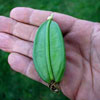|
|
|
|
|
| |
Flasks of
Coelogyne asperata 'MC8295' × 'Fulcrum' |
|
| |
|
|
| |
| Number: |
TN9369 |
| Name: |
Coelogyne asperata 'MC8295' × 'Fulcrum'
|
| Type: |
outcross (What's that?) |
|
Seed Donor: |
Troy C. Meyers
|
|
Click to Enlarge

Pollen Parent Flower |
Click to Enlarge

Pollen Parent Inflorescence |
Click to Enlarge

Pollen Parent Capsule at 179 days |
|
|
|
| |
Culture Notes from Donor: Pollen parent plant: Temperature range I (60-83°F)
Comments: Pod parent plant: One of the offspring from our TN3224 effort of 2003.
For additional origin/habitat information supplied courtesy of
Charles and Margaret Baker, see further below, near the bottom of this page.
|
Temperatures we attempt to use in the lab & greenhouse:
| For Species: |
|
Spring, Summer, Autumn, Winter: days average 86°F, nights 66°F; best fit is Warm-Intermediate 87-64°F
(Source:
Baker's Web OSC) |
| For Species: |
|
Winter: days average 82°F, nights 64°F; best fit is Intermediate 83-60°F
(Source:
Baker's Web OSC) |
|
About the name...
| Etymology of |
asperata |
|
From Latin "asperatus" rough, uneven.
(Source:
Mayr & Schmucker 1998) |
| Etymology of |
Coelogyne |
|
From latinized Greek "koilos" hollow, cavity; "gyne" woman, womb, stigma. The column is frontally hollow.
(Source:
Mayr & Schmucker 1998) |
| Pronunciation of |
asperata |
|
ass-pe-RAH-ta
(Source:
Hawkes 1978) |
| Pronunciation of |
Coelogyne |
|
see-LAW-ji-nee
(Source:
Hawkes 1978) |
|
If you would like to direct someone to this web page, please copy and paste this URL into your email:
http://troymeyers.com/d?019369
| Flask Information |
| Availability: |
Seed not viable- failed. We were not able to make any flasks. |
| You should: |
Consider placing a "Notify Retries" Request, and if an identical pollination (the same parents) is done again, we'll let you know. |
|
You might also want to:
|
View the seed assay for this item.
View items of the same species.
View items of the same genus.
|
| Ordering Information |
| You are not currently logged in. |
|
You must be a registered user and be logged in to reserve a flask or place a notification request. Please log in:
|
|
|
|
|
|
| |
The origin/habitat information below is supplied courtesy of Charles and Margaret Baker
The following information is based on the name of the plant provided by the donor, and assumes that the name is correct. If the plant has been misidentified, then the following information may not be correct.
This text is copyrighted by the Bakers and may not be reproduced without permission.
ORIGIN/HABITAT: Widespread from Malaya through Borneo, Indonesia, and New
Guinea to as far east as Bougainville and the Solomon Islands. This orchid
most frequently grows on trees and rocks in lowland forests, usually at
elevations below 1000 ft. (300 m). Plants sometimes grow as humus
epiphytes in open grassland, however. In Malaya, this lowland orchid is
found mostly on trees beside streams in primary forest. In Borneo, plants
are found in forests and on cliffs in Kalimantan, Sabah, and Sarawak
between sea level and 1950 ft. (0-600 m). In New Guinea, Coelogyne
asperata is the most common Coelogyne species and occurs almost everywhere
in lowlands. Plants usually grow below 1000 ft. (300 m), but collections
are reported near Garaina and several other locations at about 2150 ft.
(650 m). O'Byrne (1994) reports finding Coelogyne asperata in Papua New
Guinea at 5250 ft. (1600 m). In Bougainville, plants grow at elevations to
3100 ft. (950 m).
More about this information and the Bakers...
|
|
|
| |
|
|
|